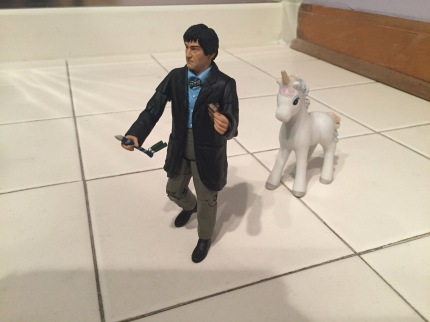“The Mind Robber” was always destined to be an oddity in the long history of Doctor Who. The fact that it has the shortest episodes of any story make its structure unique, but that is not all. Peter Ling, with an assist from Derrick Sherwin, came up with a very unusual premise; “The Mind Robber” is a story that is not set in the past, present, or future. It is a story set outside of time and space as we know it, set in the Land of Fiction, populated by fictional characters. The main antagonist is “the Master,” but it has nothing to do THE Master, since he doesn’t debut for two more years. It’s a story that I enjoy and have seen many times, yet I’m still not sure I could completely explain the Master Brain’s plan. All I know is that installing the Doctor as the new master will allow the Brain to branch out from the Land of Fiction and take over the entire Earth. However, since “The Mind Robber” has its own kind of dream logic, details aren’t important, so I just go along for the ride.

The Doctor, not-Jamie, and Zoe try to obtain information from Gulliver.
The best way to illustrate why I enjoy this story so much, however, is to direct your attention to a particular cliffhanger. No, I’m not talking about the most famous cliffhanger, the one that created the memorable image of Wendy Padbury sprawled on the TARDIS console in that sparkly catsuit. Actually, the characterization of Zoe is one of the weak points of this story; one moment she is physically besting the Karkus’ super human strength, the next she is hysterical and so illogical, like she is in the cliffhanger with the Medusa at the end of episode three, that I kind of want to slap her (but, I digress…).
Instead, the cliffhanger that I’m talking about is the ending of episode two. At its most basic level, it’s a cliffhanger like many others; a terrifying creature is menacing the Doctor, Jamie, and Zoe. The fearsome beast is charging at them and we cut away moments before certain doom for our TARDIS crew. Except, this being “The Mind Robber,” Frazer Hines is not playing Jamie and the terrifying creature…it’s a unicorn.

The Doctor is about to create not-Jamie.
That not-Jamie isn’t even the strangest thing about this cliffhanger and says a lot about this story. The most head scratching moment in this whole story is the fearsome unicorn. In episode one, Jamie mentions dreaming of a unicorn that was charging at him, so the end of episode two is his dream come to life. The interesting thing is that everybody in this story simply acts as if that’s what unicorns do. Of course a unicorn would randomly charge at unsuspecting people, I mean, what else would you expect from a unicorn?
I know that the stories about unicorns have changed over the years, but I don’t remember reading a lot of tales of the savage unicorn. It’s true that Marco Polo though that he had found a real life unicorn when he encountered a rhino, so that kind of unicorn, yes, might charge and kill you. The white-horse-with-a-horn type of unicorn, however, seems much less prone to unprovoked attacks. What kind of storybooks have they been reading? Did I miss out on a whole genre filled with tales of death by unicorn? Perhaps we just missed the moment in the Battle of Culloden when the leaders sent out the unicorn brigade to maim and kill, but I’m left wondering why Jamie is so terrified of unicorns. They’re even the symbol of Scotland, for crying out loud!

The Doctor flees a terrifying unicorn.